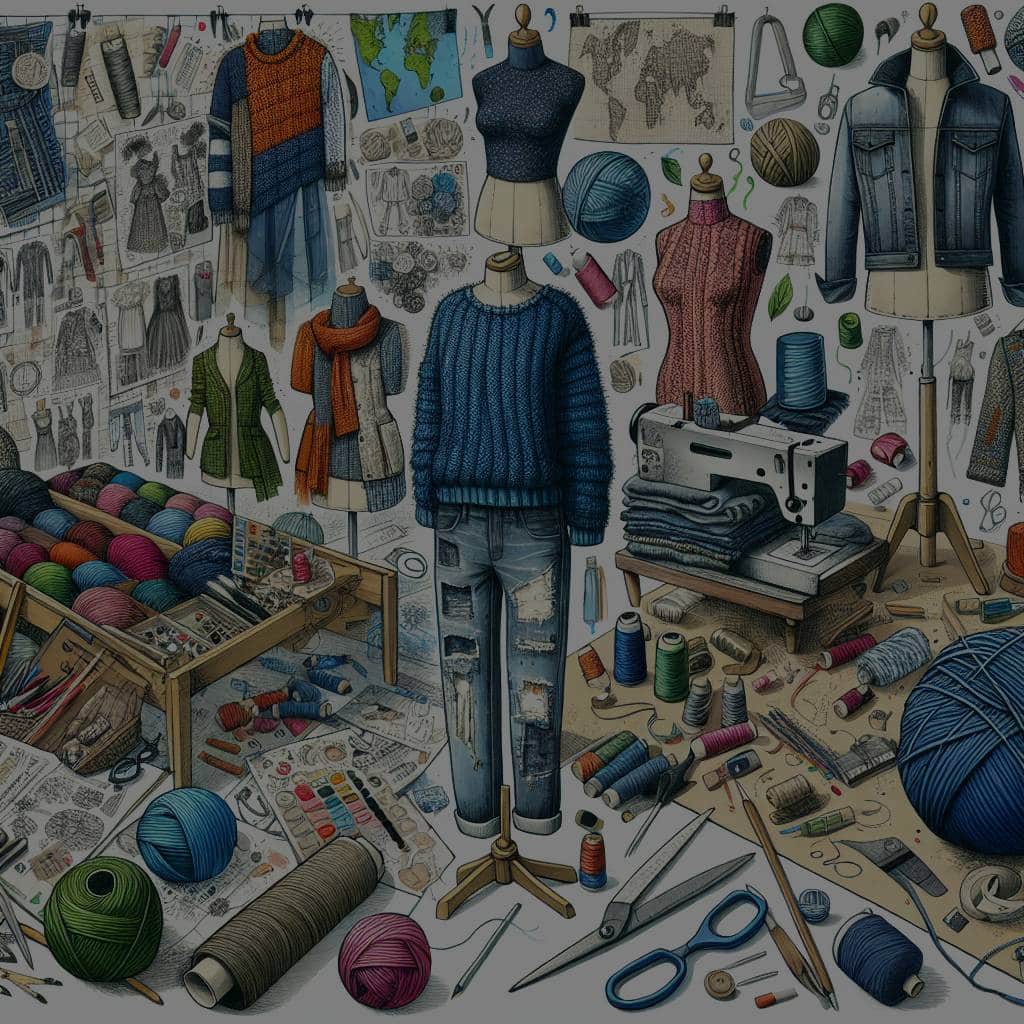What Are the Trends in Upcycling and Repurposing in UK’s Fashion Industry?

In recent years, the global fashion industry has seen a significant shift towards sustainability. Spurred on by environmental concerns and consumer demand, fashion brands worldwide are exploring innovative ways to reduce waste and promote recycling. This trend is particularly noticeable in the UK’s fashion industry, where upcycling and repurposing are gaining rapid popularity. But, what exactly do these terms mean, and how are they impacting the fashion market? This article delves deeply into these concepts, their implication on the industry, and the current trends in the UK’s fashion market.
The Concept of Upcycling and Repurposing in the Fashion Industry
The fashion industry, for many years, has been one of the top contributors to global waste. The demand for new, trendy clothing often leads to the disposal of barely worn garments, contributing significantly to the textile waste problem. However, there is a move towards a more sustainable approach, and this is where upcycling and repurposing come in.
Also read : How to Prepare for Extreme Weather Events in the UK: A Homeowner’s Guide?
Upcycling, in the context of fashion, refers to the process of transforming waste materials or unwanted products into new materials or products of better quality or environmental value. In contrast, repurposing involves adapting an item to a new use, thus extending its lifecycle. These practices are gaining traction as they offer a promising solution to reduce waste and promote sustainability in the fashion industry.
For instance, a damaged or dated garment could be upcycled into a trendy piece of clothing, or it could be repurposed—say, a sweater could be made into a cosy cushion cover. This creative approach not only minimises waste but also promotes a circular economy where resources are reused and recycled rather than discarded.
In parallel : What Are the Applications of Brain-Computer Interfaces in UK Healthcare?
Trends in Upcycling and Repurposing in the UK’s Fashion Market
The UK’s fashion market is leading the charge in the upcycling and repurposing movement, with several impressive trends underway.
Firstly, many established and emerging brands are taking up the challenge of upcycling. These brands are creatively repurposing materials into unique, fashionable clothing. For example, some brands are sourcing discarded materials such as fishing nets, plastic bottles, or leftover fabric scraps, and transforming them into stylish garments.
Secondly, there is a growing trend of ‘upcycled fashion’ retail outlets. These stores exclusively sell upcycled or repurposed clothing. Not only do these outlets provide a platform for sustainable fashion, but they also promote the concept and benefits of upcycling to a broader audience.
Thirdly, fashion education institutions in the UK are increasingly incorporating sustainability, upcycling, and repurposing into their curriculum. This educational trend will inevitably produce a new generation of designers and fashion professionals who are well-versed and committed to sustainable practices in the fashion industry.
How Upcycling and Repurposing are Changing the UK’s Fashion Industry
The rising popularity of upcycling and repurposing is creating a shift in the UK’s fashion industry. Brands are becoming more aware of their environmental footprint and are adopting sustainable practices. They are creatively reusing materials and promoting the reuse of garments, which is leading to a decrease in textile waste and a move towards a more circular and sustainable industry.
In addition, consumers are driving this change by becoming more conscious of their shopping habits. They are choosing to buy from brands that align with their values, thus pushing the industry towards more environmentally-friendly practices.
This shift is also encouraging collaborations between fashion brands and recycling companies. These partnerships are leading to the development of innovative technologies for recycling and upcycling clothes.
Challenges and Future Prospects of Upcycling and Repurposing in the UK’s Fashion Industry
Despite the progress and positive trends, there are still challenges that the UK’s fashion industry faces in terms of upcycling and repurposing.
One of the main challenges is the initial cost of implementing sustainable practices. Upcycling and repurposing require more time, effort, and sometimes, more money. This can be a deterrent for some brands, particularly smaller or emerging ones that may not have the resources to invest in these practices.
Secondly, there is the issue of consumer perception. While many consumers are becoming more conscious of sustainability, others continue to prioritise cost and convenience. Changing these ingrained shopping habits can be a significant challenge.
However, despite these obstacles, the future prospects of upcycling and repurposing in the UK’s fashion industry are promising. As brands continue to innovate and consumers continue to demand sustainability, the industry is likely to become more focused on these practices.
Ultimately, the rise of upcycling and repurposing in the UK’s fashion industry signals a notable shift towards a more sustainable future. As this trend continues to grow, it’s clear that this is not just a passing fad, but a substantial and lasting change in the way we think about and interact with fashion.
The Upcycling and Repurposing Influence on the Supply Chain and Market Share
The rise of upcycling fashion and repurposing practices in the UK’s fashion industry is disrupting the traditional supply chain and steadily influencing market share.
For decades, the fashion industry has relied on the linear supply chain model—design, produce, use, and dispose. However, the introduction of upcycling and repurposing practices is pushing the industry towards a more circular model, known as the circular economy. This model promotes the use of raw materials for as long as possible, extracting maximum value from them while in use. After use, the products and materials are recovered and regenerated.
The impact of these practices on the supply chain is evident. Brands are increasingly sourcing waste or discarded materials for production, transforming the notion of ‘waste’ into a source of value. This shift challenges the traditional idea of the supply chain and prompts companies to rethink their production methods, relationships with suppliers, and waste management strategies.
In terms of market share, brands that have embraced upcycling and repurposing are enjoying increased consumer loyalty and brand perception. A growing number of consumers prefer to support brands that align with their values, particularly those concerning environmental impact. In response, brands are increasingly marketing their sustainability efforts, further boosting their market share.
As upcycling and repurposing practices continue to permeate the industry, they will invariably influence the global market as well. It’s conceivable that in the future, the major players in the fashion industry may not be those who produce the most, but those who waste the least.
Fast Fashion vs Sustainable Fashion: Redefining the Textile Industry
Fast fashion—the rapid production of high volumes of low-cost clothing—has ruled the fashion industry for years. However, the rise of upcycling fashion and repurposing is challenging the dominance of fast fashion and pushing for a transition to sustainable fashion.
Fast fashion’s negative impact on the environment is well-documented, particularly regarding textile waste. In response, the industry is shifting towards more sustainable practices, with upcycling and repurposing playing a key role.
Upcycled fashion not only reduces textile waste but also decreases the environmental impact from the production of new materials. Producing a new garment from raw materials requires significant energy and water and results in carbon emissions. In contrast, upcycling uses existing materials, thus alleviating the strain on natural resources.
Moreover, the trend towards upcycling and repurposing clothing challenges the ‘disposable’ nature of fast fashion. It promotes a slower, more thoughtful approach to fashion, where the focus is on quality and longevity rather than quantity and speed. This shift is redefining the textile industry, as brands strive to balance profitability with sustainability.
While fast fashion may currently dominate the market share, the ascendance of sustainable fashion, driven by upcycling and repurposing, paints a hopeful picture for the future of the textile industry.
Conclusion
The upswing in upcycling and repurposing in the UK’s fashion industry marks a pivotal moment in the quest for sustainability. This shift not only addresses the pressing issue of textile waste but also pushes the industry towards more ethical and environmentally-friendly practices. It is transforming the traditional supply chain, affecting market share, and offering a counter-narrative to the fast fashion model.
Though the industry grapples with challenges—like the costs associated with implementing sustainable practices and changing consumer habits—the future appears promising. As the focus on sustainability intensifies, upcycling and repurposing are likely to become the new norm, driving the fashion industry towards a more sustainable future.
In conclusion, the rise of upcycling and repurposing in the UK’s fashion industry is more than just a trend—it represents a fundamental shift in the industry’s approach to production and consumption. It’s a clear demonstration of how the industry can evolve and adapt in response to environmental concerns, suggesting that a more sustainable and less wasteful fashion industry isn’t just possible—it’s already underway.
